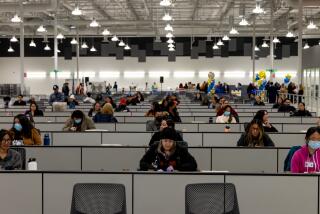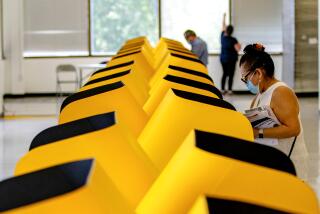Vote Boils Down to: Where’s Waldo?
- Share via
SACRAMENTO — An obscure L.A. election 34 years ago tells us a lot about who may win the Oct. 7 recall. In April 1969, city voters were asked to choose seven trustees for the newly created Los Angeles Junior College Board. The ballot listed 133 names, then almost certainly the largest number in California history.
The ballot was seven pages long, 19 names on each page. Voters were instructed to vote for seven of the 133 candidates.
For the record:
12:00 a.m. Sept. 21, 2003 For The Record
Los Angeles Times Sunday September 21, 2003 Home Edition Opinion Part M Page 2 Editorial Pages Desk 1 inches; 45 words Type of Material: Correction
Recall -- In an article on the recall ballot in last Sunday’s Opinion, it was mistakenly said that the list of R names would begin with an “Ra” name. In fact, an “Ro” name is first because O comes before A in the recall alphabet.
The top vote-getter in that election also had the most familiar name: Edmund G. Brown. Democrat Jerry Brown, son of the former governor, began his political career with election to the college board. But the winners also included five Republicans, three of whom -- Marian LaFollette, Robert Cline and current county Supervisor Mike Antonovich -- later won election to the Legislature.
The five Republicans won in heavily Democratic Los Angeles because GOP activists mailed a slate card to their voters showing them the party’s preferences. So, while Democratic voters cast ballots at random after voting for the familiar Brown name, Republicans knew who their party’s choices were and where they were on the ballot.
Finding the candidates’ names was key to victory -- and will be a key factor in the recall next month. In 1969, names were arranged alphabetically, and the ballot was the same throughout Los Angeles. This will not be the case in the October recall, which may be the most important single fact about this election.
In 1975, a court ruled that ordering names alphabetically on a ballot and listing incumbents first, as was then the habit, gave the top candidates an unfair advantage. So the ballot was changed. Names are now ordered according to an alphabet randomly selected by the secretary of state. For the October recall, names will be listed according to an alphabet beginning with the letter R (and names beginning “Ra” will be listed before any others). Names will then be listed in the following order: W,Q, O,J,M,V,A,H,B,S,G,Z,X,N,T,C,I, E,K,U,P,D,Y,F,L.
To further confuse the voter, the list of names will change in each of the state’s 80 Assembly districts. For example, the top name in Assembly District 1 will be the bottom name in Assembly District 2, and so forth. Because Los Angeles County includes all or part of 26 Assembly districts, there will be 26 candidate listings in the county alone.
This complex ballot will benefit some candidates and hurt others. In the 2000 Florida election, Democrats lost more than 20,000 votes because of ballot confusion. In one county alone, 19,000 voters mistakenly cast two votes for president because the presidential ballot ran onto a second page. In the October election, the replacement ballot will run from four to seven pages depending on the type of voting machine. Voter education is crucial. Voters can be divided into two groups: those who vote absentee and those who vote on election day. About a quarter of voters vote absentee. They will have had the time to study their ballot and pick their candidate before mailing it in.
Once the absentee vote heavily favored Republicans, but labor unions and Democratic activists have become adept at collecting absentee votes from the Democratic base. It’s probable the absentee vote will have a Republican bias, but not an overwhelming one.
Election day voters also divide into two groups. About 5 million Californians are “regular voters”: Call an election and they come out to vote. These voters are used to complex ballots; they study their sample ballot before going to the polls and know how they will vote before they enter the polling booth. These voters should be able to find their favored replacement candidate despite the confusing ballot.
But as many as 12 million voters, a California record, could descend on polls because of interest in the recall and the huge number of candidates. How will new voters unaccustomed to the complexities of the ballot box find their favorite candidate? An enormous turnout -- one recent survey found that 77% of California’s 15.3 million registered voters plan to vote -- could mean long lines and slow voting, especially with the consolidation of precincts that county election clerks are planning.
So the key to this election will be slate cards, the special voter forms sent to selected households showing voters where to find their candidate. Only two campaigns are likely to have the money or the expertise to mail out such slate cards.
Labor unions, Latino groups and other interest groups allied with state Democrats will prepare cards calling for a “no” vote on the recall but, most important, showing where to find the name of Lt. Gov. Cruz Bustamante on the ballot. This will be tricky because it will require 80 versions. But the Democratic Party is united, with virtually all aspects of the powerful Democratic machine committed to getting Bustamante elected.
The only other campaign with the funding and broad-based support to use slate cards effectively is that of Arnold Schwarzenegger. But with a fractured Republican Party, it will be more difficult to pinpoint his voters. That could be a vital difference between Democratic and Republican success in educating their voters on how to vote and making sure they can locate the party’s choice on the ballot.
In effect, Schwarzenegger must form a party for this election, especially if he’s depending on a large turnout and younger and newer voters who are likely to be overwhelmed by the 135-name ballot.
But Democrats also face a danger. If all the Democratic money goes into obtaining a “no” vote on Question 1 -- whether to recall Gov. Gray Davis -- there may be too few resources to instruct Democratic voters on how to properly cast a vote for Bustamante on Question 2, the replacement election.
So the big winner in this election may be not Bustamante or Schwarzenegger, but confusion.
More to Read
Sign up for Essential California
The most important California stories and recommendations in your inbox every morning.
You may occasionally receive promotional content from the Los Angeles Times.













